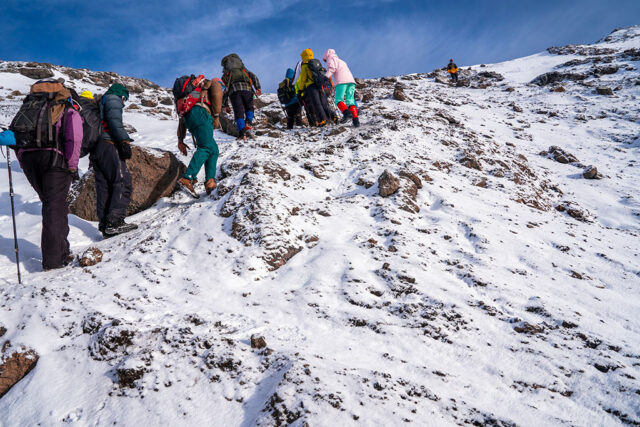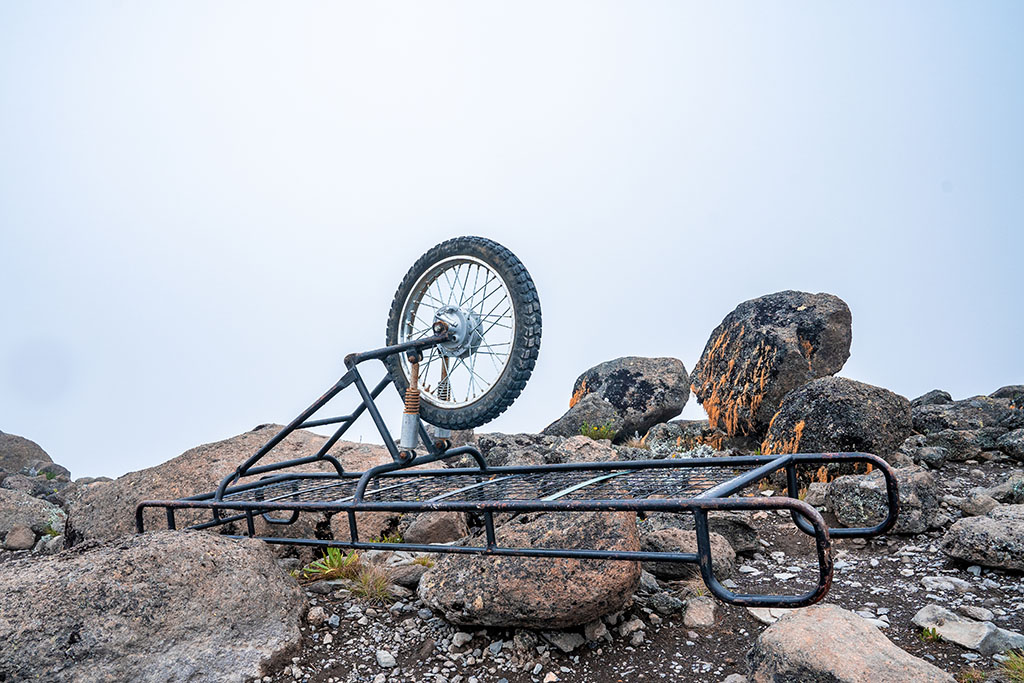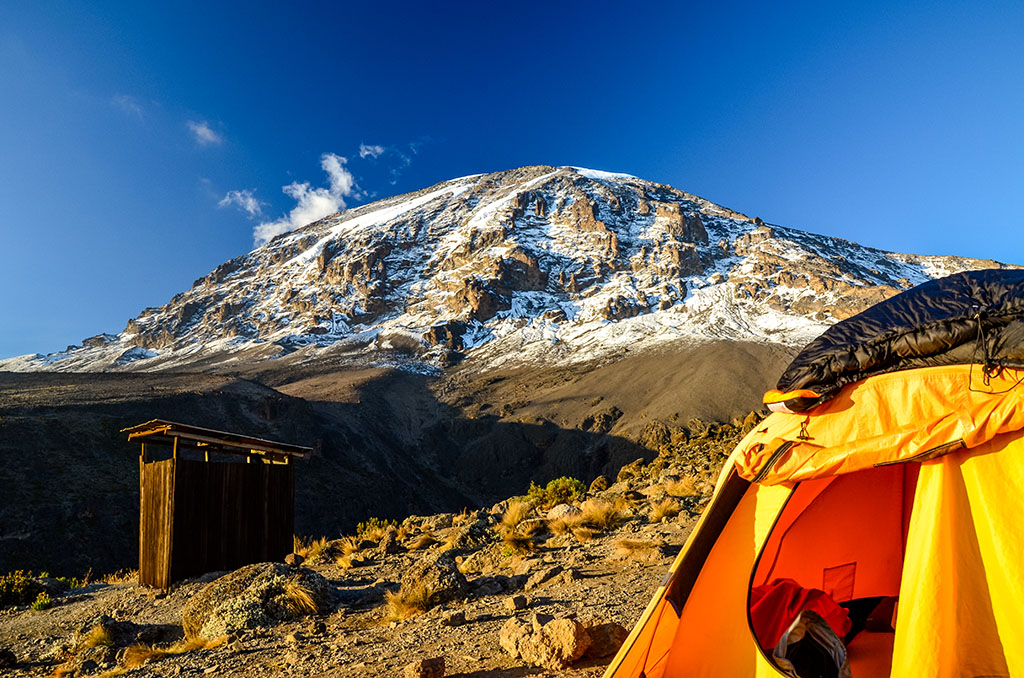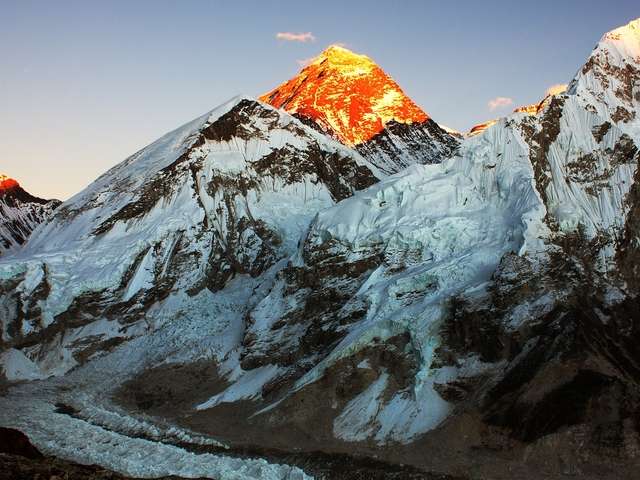
All trekkers attempting Kilimanjaro or any other high elevation trek should be aware of the potential threat of High Altitude Sickness or Acute Mountain Sickness (AMS). AMS is caused by the limited oxygen available at altitude. Atop Kilimanjaro there is half the oxygen that there is at sea level, which means you are likely to feel some of Acute Mountain Sickness’ physiological effects. There’s no understating how important it is to be aware of this potentially life threatening condition and its symptoms. It’s a common misconception that physically fit persons are less likely to feel its effects. Everyone is susceptible to AMS, it does not discriminate. For safety reasons, this article is worth a read even if you have been to high elevations without symptoms before.
Cause of Acute Mountain Sickness
The primary cause of AMS is that the amount of available oxygen in the atmosphere decreases with altitude. While the percentage of oxygen (21%) in the atmosphere remains constant the density of the atmosphere decreases so that the available oxygen when you take a breath becomes less. The decrease in density of the atmosphere is not linear and that density decreases more rapidly with increasing altitude so that the impact of going from 10,000 to 20,000 feet is not as significant as going from 20,000 to 30,000 feet.
Initial Symptoms of AMS
Above 3,500m/11,480 ft the effects of low oxygen on your body tissues become noticeable. Common initial symptoms include:
- Hyperventilation (extra breathing) under exertion.
- Minor Headache
- Increased urination
- Periodic breathing at night. Periodic breathing, also known as sleep apnea, occurs during sleep and causes you to wake up feeling that you have missed a breath. It is commonly experienced with restless sleep as your body tries to regulate itself and adjust its normal patterns at altitude.
If you have any of the above symptoms you can continue the climb and our guides will keep a close eye on you. However, if symptoms continue to progress you will have to stop the climb and head down the mountain.

More Serious Symptoms of Acute Mountain Sickness
It is easy to miss signs of the early stages of Acute Mountain Sickness as the presenting symptoms can be similar to those of dehydration, fatigue or the common cold or flu. It’s important to err on the side of safety and let your guides know what symptoms you’re experiencing. Headache is one of the most commonly experienced symptoms of High Altitude. When it presents alongside loss of appetite, nausea, vomiting, fatigue/weakness, dizziness and severe insomnia Acute Mountain Sickness can be diagnosed.
What symptoms to look for:
- Severe Headache
- Rapid Breathing and Pulse at Rest
- Nausea Vomiting
- Weakness / Fatigue / Dizziness
- Inability to Sleep
- Low Oxygen Saturation Readings
Climbers with a headache and at least one additional symptom from the above list can be considered to have AMS and must head to a lower elevation before symptoms progress.
HACE & HAPE – Severe Altitude Sickness
The real danger of AMS comes when it’s ignored and a climber does not lose elevation immediately. AMS can rapidly develop into high altitude cerebral edema (HACE) or High Altitude Pulmonary Edema (HAPE). HACE results in extra fluids and swelling of the brain and individuals present with a drunken like walk. HAPE on the other hand causes your lungs to fill with fluid and individuals present with a severe cough accompanied by pink or frothy sputum, tightness of the chest, shortness of breath at rest, a gurgling breath as if the lung is congested, a bluish discoloration of the skin (Cyanosis) and/or an abnormally fast resting heart rate of over 100 HBM. Once HACE or HAPE develops death is possible within hours unless the trekker is immediately evacuated to a lower elevation. If someone has signs of HACE or HAPE its key that a responsible member(s) of the trekking party accompany this person to a lower elevation immediately no matter the time of day or the weather conditions.
Pulse Oximetry at High Altitude
Hand-held pulse oximeters are now commonly used on the mountain to diagnose High Elevation Sickness as well as HACE or HAPE. Our guides all carry pulse oximeters and will take your reading daily. Oxygen saturation readings below 75% may be useful in the diagnosis of HAPE. A limiting factor in the use of the devices is that Oxygen saturation may remain normal as individuals tend to breathe faster at higher elevations and thus have normal readings. They are mostly used to confirm that someone who already has definitive symptoms of elevation sickness does indeed have low oxygen levels.
Photo: Tent View, Over The Clouds of Kilimanjaro
Oxygen Use on Kilimanjaro
We always carry supplemental oxygen for use in cases of severe altitude sickness. We will never let an individual use supplemental oxygen to continue climbing. If you have serious symptoms of AMS it’s imperative to head down the mountain.
Medications to Prevent Acute Mountain Sickness
The most common medication used to prevent High Elevation Sickness is Diamox (Acetazolamide). This can be easily purchased on arrival in Moshi for an affordable price and a dose of 125mg twice daily starting a day or two before ascent has been suggested by the Wilderness Medical Society. If you already have High Elevation Sickness the dose can be increased to 250mg twice daily. It doesn’t mask the symptoms of High Elevation Sickness but actually works to speed the natural acclimatization process by acidifying the blood and encouraging deeper and more frequent breaths. Though some use the drug as a preventive measure others opt to carry it with them and use upon the development of symptoms. It is commonly used on the mountain and we would not hesitate to use it upon development of symptoms such as high altitude headache. Common side effects include weird dreams and lightheadedness but are typically not worse than High Elevation Sickness symptoms.
The Facts about Proper Acclimatization
It is important not to increase your elevation too much per day otherwise you will be at a higher risk of developing Acute Mountain Sickness. Measure this by where you sleep at night and not how high or low you trek during the day. In fact trekking higher during the day and then returning to a lower elevation to sleep can increase the speed of acclimatization. It’s important to know that the routes that spend more days climbing (and therefore acclimating to the mountain) are more successful in summiting.
Acclimatization and Trekking to Uhuru Peak
A typical itinerary on Kilimanjaro is as follows:
- Moshi (2920 ft/890 m)
- Machame Camp (9,927 feet/3,026 m)
- Shira Camp (12,355 feet/3,766 m)
- Barranco Camp (13,066 feet/3,983 m)
- Barafu Camp (15,239 feet/4,645 m)
- Uhuru Peak (19,340 feet/5,895 m)
- Mweka Camp (Descent to 5,380 feet/725 m)
You will notice that most Kilimanjaro itineraries proceed up the mountain fairly quickly and do not adhere to the 1000ft/300m per day rule for proper acclimatization. One reason that this does not cause problems is that you’re not sleeping at the summit and you spend relatively little time at the highest elevations. For instance on the summit day you start from 15,000 ft at midnight, proceed to the summit (19,340 ft) by morning and head down to a lower high camp at around 13,000 feet by late afternoon. If climbers proceeded to the summit and stayed a significant amount of time many of them would suffer from AMS.

Drinking Alcohol and Coffee at High Elevation
Alcohol suppresses breathing resulting in lower blood oxygen levels and should be avoided as a general rule. Drinking any alcohol above 15,000 feet is not recommended and will leave you feeling much worse than you might expect. We recommend downing a few banana beers at the foot of Kilimanjaro afterwards to celebrate finishing the climb.
Coffee has no impact on acclimatization and if you typically drink several cups a day keep at it. If you are a regular coffee drinker be aware that stopping abruptly could cause a severe headache that might be confused with a high altitude headache.
Group Psychology and High Elevation Sickness
Several studies have suggested that individuals trekking in organized groups may be more susceptible to high elevation sickness. Individuals generally don’t want to cause difficulties for the group as a whole and might not bring up their symptoms when they first hit. It’s important to keep this in mind as an individual and maintain a level of self awareness. It’s better to rest a day and get proper acclimatization then deny symptoms which may result in an evacuation later on.
Why Choose Adventurehero?
Safety is the number one priority and our team is trained and prepared to make sure you get up the mountain safely.. Our standard operating procedures include:
- Proper Training: Our guides have all taken Wilderness Advanced First Aid with a special section on high altitude sickness.
- Experience: Our guides have all climbed Kilimanjaro over 100x and this on the ground experience is essential to recognizing AMS symptoms in climbers.
- Daily Briefing & Monitoring: We will monitor and log any symptoms along with your pulse oximeters readings on a daily basis.
If you have any questions on proper acclimatization please feel free to email us at info@adventurehero.com.
Additional Reading:
Training for Kilimanjaro
Which Kilimanjaro Route is Best
15 Tips for Summiting Kilimanjaro

















